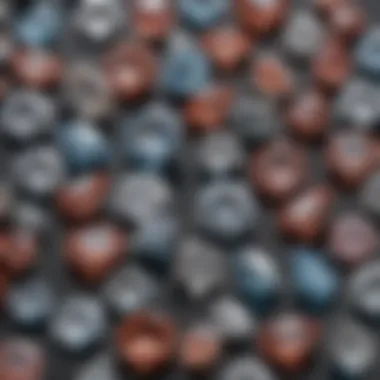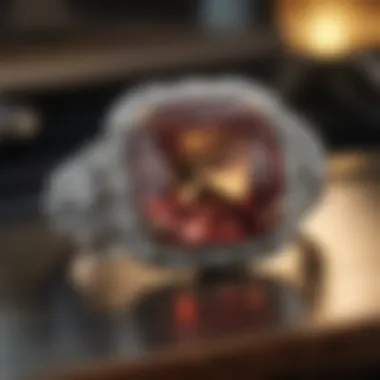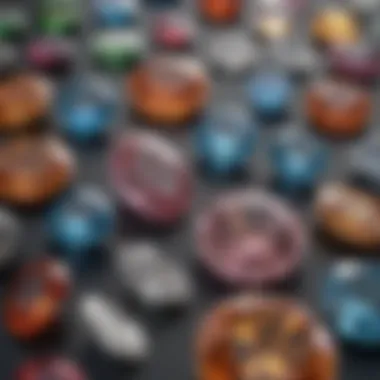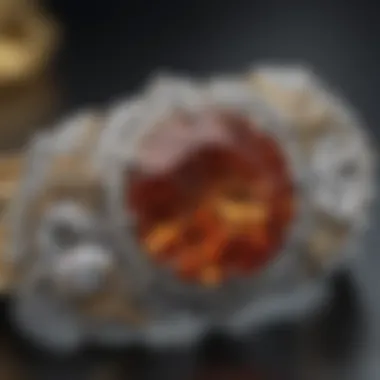Exploring the Elegance of Diamond Side Stone Shapes


Intro
Diamonds, revered not only for their brilliance but also for the careful craftsmanship involved in their design, often come with side stones that further enhance their beauty. The aim of this article is to dissect the various shapes of diamond side stones, revealing their intricate characteristics and the important role they play in jewelry design. Not all side stones are created equally. Each shape and style carries its significance in jewelry aesthetics and can dramatically transform the overall appeal of a piece. Understanding these shapes can empower gemstone enthusiasts and jewelry designers to make informed choices in their creations.
Overview of Gemstones and Minerals
History of Gemstone and Mineral Use
Gemstones have been cherished throughout history for both their visual appeal and supposed powers. As early as 4000 BC, civilizations were employing gems for both adornment and trade purposes. Ancient cultures held specific stones sacred, believing they held protective qualities, thus further embedding gemstones within their social fabrics. The evolution in the use of gemstones displays both functional and decorative aspects.
Significance in Culture and Society
Straddling art and meaningful objects, gemstones symbolize prosperity and love in various societies. For instance, in many cultures, certain stones are assigned to specific zodiac signs, reflecting personal characteristics. Diamonds, with an exceptional clarity and durability known as the hardest natural substance, exhibit intense symbolic attributes, particularly within marriage. Side stones play an important role in this sphere, emphasizing the central sentiment or theme of the rings they accompany.
Diamond Shapes and Their Significance
Each unique shape contributes differently to a piece when combined with the main gemstones. Here are some commonly admired shapes for side stones:
- Round Cut: This universally cherished shape delivers blue-white light. It is popular because it bounds perfectly with any primary stone.
- Princess Cut: A modern shape that can transform the ring's elegance, complementing a square stone elegantly.
- Marquise: Extends the appearance of length, a favored choice for creating an illusion of thin fingers.
- Oval: This versatile stone provides an appealing alternative to the traditional round cut, it can also augment a sense of harmony.
- Emerald Cut: Notably elegant and distinguished, the emerald cut enhances the visual depth of the main gemstone while retaining its grounded geometrical relevance.
Understanding how these shapes can harmonize with a primary gemstone goes beyond aesthetics; it's about conceptualizing the swirl of creativity and meaning that jewelry encompasses. Selecting the appropriate shapes influences the end value and perception of a piece of jewelry. Ultimately, a well-informed purchase can enlist a lifetime affection for such artifacts.
> "Attention to detail in both the gemstone choice and the cut shapes can often be the determining aspect in the value and elegance of a jewelry piece."
Culmination
Examining diamond side stone shapes offers both Jayptions and practical knowledge about jewelry design, letting encouagers and collectors approach gemstone evaluation from a strategic point of view. As previously articulated, being mindful of how these side stones interweave to form a beautiful tapestry enhances their initial visibility and meaning. This exploration culminates in ensuring that every jewelry piece carries not just aesthetics, but a rich narrative.
Preamble to Diamond Side Stones
Diamond side stones play a critical role in the composition and overall aesthetic of jewelry. These stones are not merely ornamental additions. They serve a vital function in enhancing the center stone, typically a diamond. By placing different shapes and cuts around the main gemstone, designers create a layers of visual interest.
Key Aspects of Side Stones
- Aesthetic Influence: Side stones can transform the perception of the center stone, influencing the viewer's gaze and emotional response.
- Balance and Proportion: The right combination of shapes fosters balance, allowing the jewelry piece to maintain proportionpe.
- Versatility: With a myriad of shapes available, from classic round cuts to elaborate trillion cuts, these stones offer designers endless possibilities to communicate style and design ethos.
When assessing side stones, both gemstone enthusiasts and jewelry designers must consider how the huolet of these stones interplays with the primary gemstone. The aesthetic notion of high value extends beyond just the center stone. Side stones contribute significantly to the overall character.
Considering historical context, a myriad of cultural significances are attached to the shapes and arrangements of these stones. Understanding their evolution also helps clarify fundamentals and preferences in present-day jewelry design. This article will explore these critical facets of side stones, guiding both collectors and designers in making informed decisions to impart meaning and beauty to each piece.
The Role of Side Stones in Jewelry Design
Diamond side stones play a crucial role in jewelry design, often overlooked but essential to creating a captivating piece. Their purpose extends beyond mere decoration; they have significant impact on the overall dynamism of any jewelry item. Choosing the right side stones can enhance the visual appeal, draw the eye to the center stone, and establish a particular theme or mood for the piece.
Enhancing the Center Stone
One of the primary functions of side stones is to enhance the center stone. Center stones are often bold and centrally positioned, serving as the focal point of the design. Side stones can serve to vibrantly frame and highlight the central gem. Their sparkle can soften or amplify the qualities of the main stone, depending on the style of the design. When properly chosen, side stones can envelop the center stone, allowing it to shine even brighter against a background of complementary colors and shapes. For example, the use of round cut diamonds on either side of an emerald cut center stone can create depth, making the colors and cuts stand out in contrast.
Creating Balance and Harmony
In addition, side stones contribute significantly to the balance and harmony of a jewelry piece. Symmetry is a fundamental principle in design; side stones can help to achieve this. Well-placed stones can yield a sense of completeness making the item visually pleasing. This means not just matching shapes or colors, but also ensuring that the size and weight of side stones are proportionate to the center stone. The choice of the shape of side stones can also define the overall flow of the jewelry. For instance, pairing softer shapes like cushions with sharper ones, like baguettes, can invoke an unexpected visual harmony. In every aspect, the placement of side stones enables jewelry designers to create an aesthetically fulfilling product.
Stylistic Expressions


Lastly, side stones offer a means of stylizing a piece further. Each cut and shape tells a different story and can be a reflection of the wearer’s personality. From delicate trillion cuts to bold marquise shapes, configurations can evoke vintage-inspired looks or contemporary styles. Designers leverage side stones to channel distinct motifs — whether aiming for elegance with princess cuts or a more daring expression with asymmetric placements. Therefore, these gem shapes don’t just enhance or balance; they serve as a reinforcement of artistic intention and personal expression in design.
Side stones are not merely decorative. They encapsulate the aesthetic philosophy, adding both beauty and meaningful context to jewelry design.
In summary, acknowledging the profound role of side stones in jewelry design is vital. Their ability to enhance the center stone, create balance, and offer unique stylistic expressions can completely redefine a piece. When selecting side stones, one must carefully consider how they will interact with the main gem, aligning with both the designer's vision and the wearer's identity.
Popular Side Stone Shapes
The shapes of side stones hold a significant role in the overall design of diamond jewelry. The right side stone shape can elevate the center stone, adding depth and character to a piece. Various shapes offer unique visual features and can enhance or contrast beautifully with the primary gemstone.
Choosing a side stone shape is not merely about aesthetics. It involves understanding how each shape interacts with light, complements the center stone, and aligns with the style of the wearer. This decision can affect the overall harmony and appeal of the jewelry. Let's explore some of the popular shapes of diamond side stones.
Round Cut Stones
The round cut is arguably the most popular shape for diamonds. Its design maximizes brilliance and sparkle, making it a favorite among many jewelry designers. In a side stone role, round cut stones bring not just beauty, but also vibrancy.
Round cut stones typically work well with any center stone shape. They can elevate even the most simple designs, providing a classic look. These stones are oftentimes calibrated size-wise, allowing for seamless integration into many settings. The round shape’s uniformity helps to not overshadow the center stone, creating a balanced visual appeal.
Princess Cut Stones
The princess cut is a contemporary option known for its sharp corners and brilliant facets. This diamond shape is a striking choice for side stones, providing a unique contrast, especially with softer round cuts.
When used as side stones, princess cut diamonds deliver a modern elegance. Their angular design communicates a sense of sophistication. The well-defined shape can sometimes give sharper edge to the overall look of a piece, creating an interesting dynamic to the visual representation.
Emerald Cut Stones
Emerald cut stones are rectangular with stunning step cuts in their facets. They have a unique personality due to their broad, open table which showcases the clarity of the diamond more than others. When incorporated as a side stone, emerald cuts can add an air of grandeur to the jewelry.
The long lines of emerald cuts can elongate the appearance of the wearer's hands, and they usually provide a contrast to the round or princess cut center stones. Their understated elegance makes them an intriguing option for side stones, typically fitted to more modern designs.
Cushion Cut Stones
Cushion cut stones are another popular option for side stones. Often referred to as pillow cuts, these stones marry the strong lines of emerald cut with the soft, rounded edges of the round cut. They tend to provide a historic charm, suitable to vintage-inspired jewelry.
Their romantic appeal can add depth when styled alongside sleek center stones. The unique faceting allows for great sparkle, making cushion side stones a desirable companion to many centerpiece shapes.
Oval Cut Stones
Oval cut stones preserve the brilliance of round cuts while providing a different silhouette. Their elongated shape can create a flattering view, especially when used as side stones next to round cuts.
These side stones can be versatile, working harmoniously with various center stone shapes. The refined elegance of oval cuts can work well within many settings, giving the piece an overall elongated appearance that can be appealing for many tastes.
Marquise Cut Stones
Marquise cut stones are innovative with their distinctive boat shape. They create a striking silhouette that's excellent for side stones. Attractive and dramatic, they can enhance the elegance of other stone shapes, especially round cut center stones.
Their form can not only elongate but also amplify the brilliance and surface reflection due to their unique faceting. Utilizing marquise stones as sides can provide a vintage vibe, leveraging the classic 18th century design narrative.
Baguette Cut Stones
Baguette cut stones are slender, simple cuts that can lend an art deco flair to jewelry designs. The clean and linear design provides an intriguing contrast to commonly shaped center stones.
Using baguette cuts as side stones can create a chic and minimalist approach. Their sleek presence can support or highlight another center stone without being overpowering. Hence, best suited in settings that aim for subtle sophistication.


Trillion Cut Stones
Trillion cut stones flaunt their triangular shapes with beautiful facets and crisp lines. They are gaining more and more popularity, showcasing a modern approach to side stones.
Their sharp edges can create a dramatic impact when placed beside defined center stones, thereby enhancing the overall aesthetics. Trillion cuts can bring a futuristic design vibe, suitable for those who appreciate contemporary jewelry styles.
Choosing the Right Side Stone Shape
When it comes to selecting side stones for jewelry, the choice of shape is a vital consideration. Side stones must complement the center stone while reflecting your personal style. Making informed decisions can enhance the overall aesthetic of a piece and ensure it meets both your needs and those of the market. Here, we delve into important elements to consider when choosing the right side stone shape, the benefits of various choices, and factors to weigh in this decision-making process.
Compatibility with the Center Stone
The first and foremost consideration in choosing a side stone shape is its compatibility with the center stone. The harmony between the shapes contributes significantly to the visual appeal of the entire piece.
- Shape Matching: For instance, a round cut center stone often pairs well with round side stones; however, creative choices may include mixing it with princess or oval shapes. Knowing how shapes interact remains essential in jewelry design.
- Size Proportions: The scale of the side stones in relation to the center stone must also be considered. Too large side stones can overpower the center stone, while too small side stones may look disproportionate.
Setting and Style Preferences
Choosing side stones also involves considering the overall setting and style preferences. The type of setting impacts which stone shapes will perform best visually and structurally.
- Setting Types: Ruby side stones in pave settings work best when they have a smaller and consistent shape, while larger diamonds often require more elegant setting styles like prong settings.
- Jewelry Trends: Staying updated with current trends can also guide your choice. For example, vintage styles might benefit from pear and marquise shapes, while modern settings may favor clean, geometric shapes like baguettes.
Artists in design often merge specific styles with their personal vision to produce unique pieces. It pays to ensure that side stones adhere to the intended aesthetic while retaining structural integrity within the setting.
Personal Taste and Aesthetic Goals
Ultimately, personal taste remains a decisive factor when choosing side stone shapes.) Individual preferences shape the jewelry outcomes and represent one's identity.
- Use of Color: The inclusion of colored gemstones can add character; shapes like trillions and ovals serve as great focal points alongside a classic diamond center stone.
- Trendy vs. Timeless: While current trends may influence choices, design should not rigidly adhere to momentary fashions. Each piece should convey a narrative that aligns with the their own values and emotional sentiments.
In sum, your unique aesthetic goals must inspire all of your choices when selecting side stones. By emphasizing personal connection an attitude, the final piece could become a cherished possession rather than just ornament.
Astrology and personal taste are often at the mercy of the beholder; instrumentalizing the design allows personal articulation while upholding beauty.
Historical Context of Side Stone Shapes
Understanding the historical context of side stone shapes is essential for appreciating the artistry and significance these elements contribute to jewelry design. Side stones have transitioned remarkably over time, adapting to both changes in technology and evolving societal standards. As diamonds and other precious stones became widely accessible, jewelers sought innovative styles to enhance their designs. This evolution raises considerations regarding aesthetic preferences and construction methods that were specifically tailored to maximize the beauty of the primary stones.
Evolution of Cut Techniques
The development of cutting techniques significantly impacted the way side stones were perceived and utilized. Early techniques focused predominantly on simplistic shaping, consisting primarily of raw gemstones with minimal alterations. As time progressed, artisans learned to manipulate facets of precious stones in a way that magnified brilliance and light reflection.
The most notable advancements in cutting occurred during the late 19th and early 20th centuries. For instance, the advent of the brilliant cut allowed for far greater light interaction, leading to a sparkling effect that refined the visual impact of side stones. This advanced cutting technique results in heightened versatility, catering to various side stone shapes such as round cuts, princess cuts, and other popular forms.
Cultural Significances
Throughout history, side stone shapes have held unique cultural significances, dictating their use in jewelry across different societies. In ancient Egypt, for example, colored stones were often combined with diamonds to symbolize protection and power, enhancing their importance. Meanwhile, in contemporary society, side stones have come to represent not just beauty but also personal milestones and emotional connections.
Different shapes retain varied meanings and associations.
- Round Cut: Often symbolizes eternity.
- Cushion Cut: Associated with romanticism and nostalgia.
- Emerald Cut: Represents sophistication and elegance.
Jewelry features using particular shapes have long been integrated into rituals or traditions, reflecting the attitudes and symbols assigned by specific cultures.


In coralating cut styles with social trends and tastes, one recognizes a broader narrative in the evolution of gemology and jewelry design.
To conclude, an examination of the historical context of side stone shapes reveals their intricate connection to culture, artistry, and cutting edge style, resonating deeply with anyone engaged in the field of gemstone jewelry.
The Impact of Side Stone Shapes on Value
The selection of side stone shapes can greatly affect the value of a piece of jewelry. Side stones not only complement the center stone but also add unique characteristics that can influence both market desirability and appraisal values. Therefore, understanding the interplay between these shapes and the overall value of jewelry is essential for enthusiasts and designers.
Market Trends
In the jewelry market, trends in side stone shapes can directly reflect broader aesthetic preferences and demand among consumers. Certain shapes may rise in popularity, influencing their value. For example, Round Cut stones are generally favored due to their brilliance and versatility, leading to a stable market demand. In contrast, styles like Trillion or Baguette cuts may trend less frequently, causing their values to fluctuate depending on current fashion.
- Collectability: Shapes that gain popularity can become more collectable. For example, Princess Cut stones saw a rise in favor until the late 1990s. They are now recognized for their modern appeal, often boosting their value adjacent to Round shapes.
- Fashion Cycle: As fashion changes, certain shapes might see renewed interest. Emerging designers may favor distinctive cuts, like Marquise, to create unique jewelry pieces, which can also elevate their perceived value.
Factors Influencing Pricing
There are several factors that make the pricing of side stones an elaborate matter. These factors, influenced partially by their shapes, can determine the final store price or appraisal value.
- Rarity: Certain shapes, especially unique cuts, are rarer to find. For instance, Trillion and Baguette stones are less widely available, potentially increasing their demand. Higher rarity can lead to higher value.
- Carat Weight: Different shapes distribute weight variably, affecting how much of the rough stone is utilized. An Oval Cut retains much of its rough selection, which can affect pricing based on how useful the raw material is deemed.
- Craftsmanship: The quality of the cut will greatly influence value. Certain shapes require superior artisan skills to achieve the desired aesthetic, creating disparities in pricing across shapes even if they have the same number of carats.
“Understanding the market and the particular trends of stone shapes can help customers make informed purchasing decisions.”
In summation, the impact of side stone shapes on value extends to multiple dimensions that exceed mere aesthetics. Knowing current market trends and the underlying factors affecting pricing helps guide gemstone enthusiasts and jewelry designers in their selection process. This understanding ultimately aids in making choices that reflect both personal taste and financial acuity.
Maintenance and Care of Side Stones
Maintaining and caring for diamond side stones is crucial in preserving the beauty and longevity of a piece of jewelry. These side stones, regardless of their shape, deserve attentive care to maintain their brilliance and visual appeal. Regular maintenance helps prevent damage and deterioration, extends the lifespan and ensures that the side stones continue to accentuate the central gem effectively.
Effective care practices can protect side stones from scratches, dirt buildup, and other environmental factors. Over time, neglect can lead to significant wear that diminishes the aesthetic value of intricate designs. By implementing proper maintenance techniques, wearers can not only ensure that their jewelry maintains its value but also continue to showcase the intricate craftsmanship involved in its creation.
Cleaning Techniques
Cleaning side stones not only enhances their appearance but helps improve clarity by removing buildup of oils, dust, or grease. Certain cleaning methods suit specific shapes of side stones, yet some general techniques can be employed regardless of cut style.
Typically, a solution of warm water with a mild soap is effective for cleaning jewelry. Here are the steps involved:
- Prepare a Solution: Mix a few drops of mild soap in warm water.
- Soak the Jewelry: Allow your jewelry, including side stones, to soak for around 15-20 minutes.
- Clean with a Soft Brush: Use a soft toothbrush or jewelry brush to clean around the stones gently. Be cautious around prongs or settings.
- Rinse with Clean Water: After brushing, rinse the jewelry in warm water to remove any soap residue.
- Dry with a Soft Cloth: Finish by gently patting the jewelry dry with a clean, soft cloth.
Overly harsh chemicals and abrasive materials should be avoided since they can scratch or dull the database of your gemstone.
Proper Storage
Storing jewelry correctly can prevent damage not only to the side stones but also to the main gemstone. When side stones are safely stored, the chances of scratches, cracks, and breakage decrease significantly.
Here are some storage tips you may find beneficial:
- Use a Soft Pouch or Lined Box: Soft pouches reduce chances of scratches during storage, while cushioned boxes provide additional protection.
- Avoid Stacking: Keeping different jewelry pieces stacked together may increase the risk of tangling or scratching.
- Separate Storage Options: If possible, list items for pieces containing various cuts or materials, as certain stones can damage others.
- Climate-Controlled Environments: Store diamond jewelry in a cool, dry place to avoid humidity and heat, which may damage the stones over time.
Regular maintenance in cleaning and storage of your diamond side stones is not just upkeep; it is essential for overall piece aesthetics and investment.
With proper attentiveness to the care protocol, individuals can ensure that they maximize the longevity and impact of their diamond side stones.
End
The role of side stones in jewelry is multifaceted and profoundly significant. This article has explored the diverse shapes available, providing insight into how each contributes uniquely to overall jewelry design and value. Understanding these differences is crucial for gemstone enthusiasts, collectors, and jewelry designers alike.
Several specific aspects emerge as particularly important when considering diamond side stones:
- Design Cohesion: Side stones play a key role in achieving harmony within a piece. When chosen appropriately, they can elevate the central stone’s presence while maintaining a balanced overall aesthetic.
- Personalization: Selecting side stones that align with one’s personal taste and style not only imbues the jewelry with individuality but also cultivates a deeper emotional connection to the piece.
- Market Considerations: The value of side stones significantly influences the pricing of gemstone jewelry. By comprehensively understanding market trends and historical value, one can make more informed purchasing decisions.
- Maintenance: Proper care is integral in preserving the beauty of side stones. Knowledge of cleaning and storage requirements ensures longevity, maintaining their brilliance over time.







